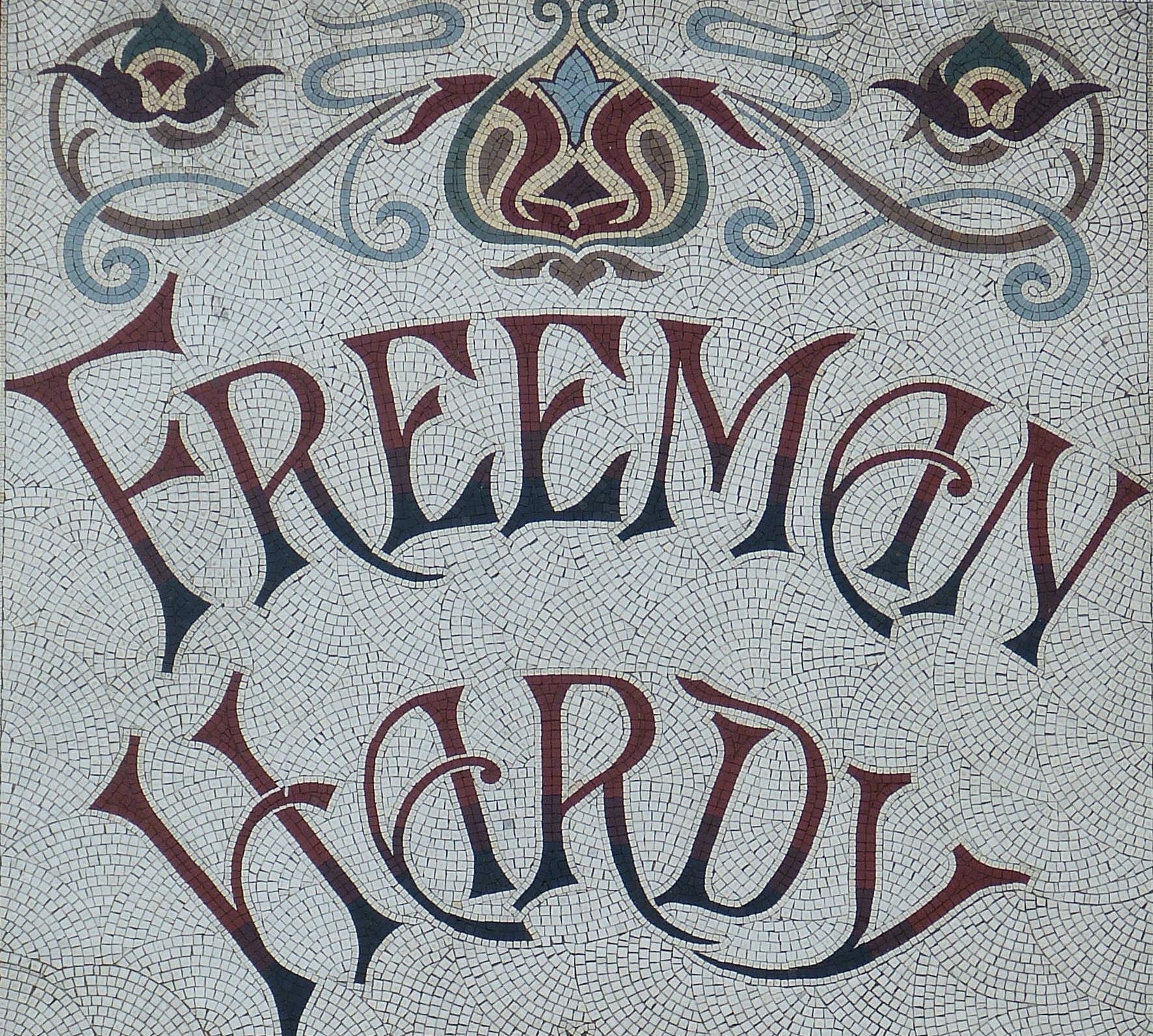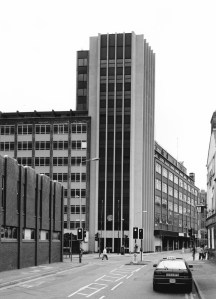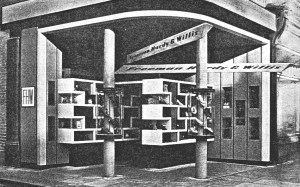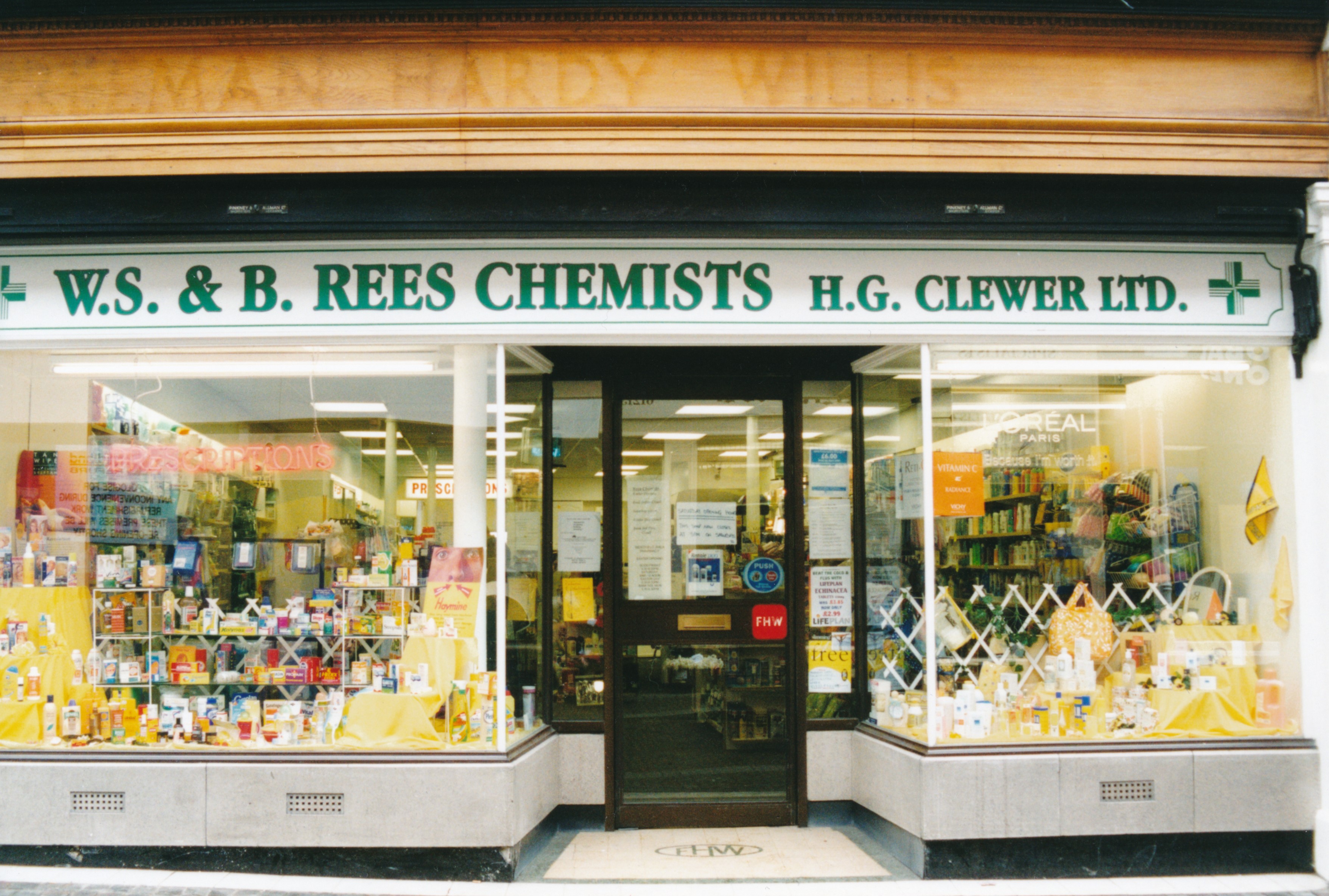
Market Place, Hitchin: detail of mosaic sign. (R. Baxter)
Introduction
Boot and shoe dealers were amongst the first chains of shops to emerge in the mid-to-late 19th century. Many sprang up when footwear manufacturers decided to eliminate the middleman and sell their products direct to customers through their own retail branches. A few, like Timpson, subverted this commercial model by starting as retailers and only later branching into manufacture.
Early chains included Freeman, Hardy & Willis, Cash & Co, Lilley & Skinner, Stead & Simpson, True-Form, Lennard and Milwards. Following in their footsteps in the 20th century were Barratt, Manfield, Saxone, Lotus & Delta, Dolcis, Peter Lord (Clarks), and many more. Once household names, most of these have long gone. They thrived in an age before imports effectively destroyed Britain’s native footwear industry, severing the link between the factories and their outlets.
This series of posts on the shoe shops of the past begins with Freeman Hardy & Willis, whose fascia was a common sight on British high streets until the company’s demise in 1996.

Sandwich, photographed 2009
The Story of Freeman, Hardy & Willis
Freeman, Hardy & Willis was created in Leicester in 1875 and formed into a limited liability company with £20,000 capital in December 1876. Described as ‘boot and shoe manufacturers and factors and leather merchants’, it was named after its three directors: William Freeman, Arthur Hardy and Frederick Willis. Rather remarkably, Hardy was an architect by profession. Soon after incorporation, in 1877, the partnership was dissolved and the company merged with E. Wood & Co., a manufacturing firm established by Edward Wood (1839-1917) in the 1860s. As Chairman, Wood assumed responsibility for the subsequent success of Freeman, Hardy & Willis. He became a local worthy, receiving a knighthood in 1906 and serving as mayor of Leicester on four occasions.

Pearl granite stall risers and mosaic floor at Bideford, c.2000. (K. Morrison)
Shops bearing the Freeman, Hardy & Willis signboard began to open by 1879, if not before. Early branches included Leamington Spa, Lincoln and Leeds. These outlets retailed own-brand footwear for men, women and children and, like most multiples, sold for ‘ready money’ (cash) only. They were stocked from a ‘handsome warehouse and manufactory’ built in Leicester in 1876-77. Occupying the corner of Rutland Street and Humberstone Road, the building was constructed by Gilbert & Pipes, local builders, at a cost of £6,100. It was fitted with up-to-date machinery, including Wright’s blocking machines, Gimson’s presses and Grimes’ lift cutters. The manager was John Butcher. No evidence has turned up, but one wonders if Arthur Hardy was the architect.

Freeman, Hardy & Willis’s works on Rutland Street, Leicester, in 1878
Growth was astonishingly rapid. By 1887 Freeman, Hardy & Willis boasted 130 outlets. This grew to 150 by 1890, 200 by 1894, and 300 by 1903, when the London chain Rabbits & Sons was acquired. Later takeovers included Pocock Bros. and Hall & Co. These acquisitions helped Freeman, Hardy & Willis expand to 460 shops on the eve of war in 1914. In the early years the firm was advertised as ‘The Boot Kings’, ‘The Boot People’ or ‘The People’s Boot Providers’, but by 1900 it was claiming to be ‘The Largest Boot and Shoe Dealers in the World’. By then the shops had separate ladies’ rooms and repair departments.

Repair Depot, Orchard Street, Canterbury. This building probably dates from c.1925-30. Behind the façade the workshop was lit by north-facing lights in a sawtooth roof. (c.Historic England)
Information about Freeman, Hardy & Willis’s building and shopfitting activities is not easy to come by, though disparate archives exist and this might be a fruitful field of study (for someone else, some day!). Evidently some properties were bought outright whilst others were leased, and the majority were converted or refitted rather than being new-build. The most tangible remnants of the shops are mosaic tiles on the floors of entrance lobbies, with the initials ‘FHW’ rendered in various styles. In addition, a very splendid mosaic sign survives on the canted corner of a building that housed the Hitchin branch from c.1900. The shopfitter F. E. and G. Maund was responsible for the branch in Forest Gate in 1898, and may have worked for the firm on a regular basis.

Market Place, Hitchin, Hertfordshire. (R. Baxter)

Hitchin. (K. Morrison)
 In 1908 Freeman Hardy & Willis announced that it was discontinuing manufacture in London – presumably a reference to a factory inherited from Rabbits & Sons – to concentrate on its Northamptonshire factory, which was in the throes of extension. The Kettering Boot & Shoe Co., which had supplied Freeman Hardy & Willis since 1879, was taken over directly in 1913 (factory dem. 1996). Jonathan North (1855-1939) was appointed Sir Edward Wood’s successor as the Chairman of Freeman Hardy & Willis in 1912 and subsequently, in 1925, Leavesley & North Ltd was acquired. In 1928 Freeman, Hardy & Willis was bought out by J. Sears & Co, which traded as the True-Form Boot Co of Northampton. Once united, True-Form and Freeman, Hardy & Willis – which maintained their separate identities – had 720 shops.
In 1908 Freeman Hardy & Willis announced that it was discontinuing manufacture in London – presumably a reference to a factory inherited from Rabbits & Sons – to concentrate on its Northamptonshire factory, which was in the throes of extension. The Kettering Boot & Shoe Co., which had supplied Freeman Hardy & Willis since 1879, was taken over directly in 1913 (factory dem. 1996). Jonathan North (1855-1939) was appointed Sir Edward Wood’s successor as the Chairman of Freeman Hardy & Willis in 1912 and subsequently, in 1925, Leavesley & North Ltd was acquired. In 1928 Freeman, Hardy & Willis was bought out by J. Sears & Co, which traded as the True-Form Boot Co of Northampton. Once united, True-Form and Freeman, Hardy & Willis – which maintained their separate identities – had 720 shops.

Letchworth, 1930s: note the date 1877 in the window.
Freeman, Hardy & Willis’s Rutland Street headquarters was bombed in 1940. Following a close study of American warehouse methods, a new modern office block – Enterprise House – was erected on the old site in 1955-57, to designs by Lewis Solomon Son & Joseph. This was converted into a hotel around 1970, but the site is currently being redeveloped yet again.

The Rutland Street Headquarters in 2001. (c.Historic England)

Catford.
One particular Freeman, Hardy & Willis shop caught the imagination of the architectural press after the Second World War. This was the Catford branch, built in 1953 to a design by the modernist architect Patrick Gwynne (1913-2003). Set on a corner, the recessed shopfront featured display cases wrapped around structural columns, suspended signs, and staggered display shelving. The shopfitting was by A. Davies & Co of London, who were also responsible for the Putney branch of the late 1950s. The architects of Putney were Bronek Katz & Vaughan, who also worked for Bata. Bronek Katz & Vaughan had probably been commissioned by Nadine Beddington, who became Freeman, Hardy & Willis’s advisory architect in 1955. From 1957 until 1967 she was the Chief Architect to Freeman Hardy & Willis, True Form and Character Shoes, all part of the British Shoe Corporation (BSC).
The BSC was the brainchild of Charles Clore. As Chairman of J. Sears & Co, he sold a great deal of shop property in 1953, raising millions which he invested in diverse businesses. The umbrella company was renamed Sears Holdings in 1954. It acquired Character Shoes, a 50-strong chain, in 1954, then Curtess Shoes, Manfield, with 180 branches, and Dolcis, with 250 branches, in 1956. These were bundled together as the BSC, with six factories and 1,500 shops. Saxone and Lilley & Skinner, which had merged in 1956, were acquired by the BSC in 1962.

The former Leominster branch in 2000. Note the lobby floor as well as the ghost lettering on the fascia. (K. Morrison)
By the early 1990s times had changed. A struggling BSC was restructuring and Sears was selling off hundreds of poorly-performing shoe shops. Changing footwear fashions and cheap foreign imports had transformed this area of retailing. Freeman Hardy & Willis was sold to Fascia for £11.7 million in 1995. Fascia’s collapse a year later brought about the closure of all remaining Freeman, Hardy & Willis shops. Just scant traces of the firm survive, notably its mosaic tiling, but not enough to leave a strong impression of a distinctive and lasting house style.

Click here to read about the boot and shoe industry in Northamptonshire.

There’s an excellent Freeman, Hardy Willis ghost sign in Market Harborough https://www.flickr.com/photos/10515323@N08/15862007325/in/photolist-qaEW9V-i9LZud
LikeLike
Thank you for this! I’ve been trying to work out the location of a photo taken by some WW1 soldiers, and the only clue was a FHW sign in the background. It’s the same sign you linked to! Thanks ever so much!
LikeLike
It’s being restored as we speak , I don’t know how to upload a picture,it looks fabulous though
LikeLike
Thank you so much for this I have been looking for years about this my grandfather was Herbert Willis his father was Frederick Willis I have been told by a family member that our grandfather came from England when he was 16 with his uncle Thomas Willis who was the brother of Fredrick Willis who work with the Freeman Hardy and Willis.This is the most info I have been able to find.
Nancy Willis
LikeLiked by 1 person
Nancy!!!
I’m especially happy to come across this as well… Thanks for sharing*❤️
LikeLike
Hi Nancy, my great great grandfather was Frederick Willis of FHW. Email if you would like further information, as it appears we are related.
Ed.
LikeLike
Fascinating stuff, thank you. I remember discovering that the British Shoe Corporation owned all those shoe stores when, aged 16, I had a Saturday job selling shoes at Dolcis and then Freeman Hardy and Willis. The latter job was during the three-day week in early 1974 when the power cuts meant we had candles lighting the shop! Interestingly most of the shoes for FHW were made by the same manufacturer as those for Dolcis, the only difference being they were more cheaply made and priced lower.
LikeLike
Great article. I was looking back down memory l and and wondered if there was anything on the company where I had my very first job. I worked in the Bristol Broadmead branch from 1984 till 1986ish. Fabulous elderly couple were in charge but soon retired and never was the old adage “out with the old, in with the New “was never truer than there. If I took one thing from my first job it was customer service. I was thought well and it served me in all my working life since. Happy memories.
LikeLike
I WORKED FOR FREEMAN HARDY AND WILLIS FROM 1963 UNTIL THEY CLOSED IN 1997.
THEY ALSO HAD A REPAIR DEPOT IN PECKHAM,SOUTH LONDON; OGLANDER ROAD;
THE MANAGER WAS MR LOVELL
LikeLike
For reference there is a British Shoe Corporation facebook page which includes FHW. I run the site. Chris Huscroft
LikeLike
Hello Geoff, I hope your well. I remember selling the “R Dubs” (shilling in the pound commission) whilst you were on relief in 1507 ( north end) Croydon…. good times. I went on to manage Nottingham, Birmingham and Newcastle upon Tyne.
LikeLike
Hi Geoff, Just clicked on this whist I was doing some family history are you the Geoff Foster who took over the Deptford branch from me in 1967
LikeLike
hi Geoff – Mr Lovell was my Grandpa. He lived in Tooting and I think initially worked at a shoe store at the end of Vant rd on Mitcham Rd, then obv went to work in Preston. My Grandpa retired and moved to Australia with us in 1979. He and my Nana lived with us until they passed away (1991 and 1999). My Grandpa was a wonderful man and I have many happy memories of him. Thank you for mentioning him
LikeLike
I worked for Freeman Hardy Willis in Briggate Leeds in 1969 I went straight from school loved it
Mr Silkstone was the boss and Mrs Spinks was in charge of the staff.
I remember to boost sales we had to sell shoe cleaners with our sale I think it was melatone
We also had to stand in the doorway and greet the customers,also we would stand in the shop entrance with a table and sell stockings etc. Mr Silkstone took the job very seriously
We also had competition to see who could sell he most handbags in a week we would get a few shillings first prize. My first weeks wage was five pounds ten shillings happy memories
Joyce Hill nee woods
Any one else remember Briggate Leeds,
LikeLike
For reference there is a British Shoe Corporation facebook page which includes FHW. I run the site. Chris Huscroft
LikeLike
My grandfather worked at FHW in 1921 as a boot repairer. He was 17 at the time.
LikeLike
My grandfather, Joseph Tunnard Kitchen was manager of and FHW branch, I think, in Lincoln or Thirsk in the early years of the 20th century. Any information would be grately appreciated, thanks Peter Vickery
LikeLike
My grandfather Arthur Walters worked in Aldershot FHW. I have his retirement watch which dates his service from 1927 – 1960. I have happy childhood memories visiting his shop in Aldershot
LikeLike
I am researching Frederick Willis, handbag manufacturer from London area around 1955. Can you tell me would. this be the same Frederick Willis or any connection.
Thanks in advance.
LikeLike
My father Bert Harget started working for FHW in Aberyswyth in 1934, he then moved to Clapham before WW2. when he returned at the end of the war he was made manager of the Fratton Road branch in Portsmouth, from there we (I was born over the shop in 1947) went to Basingstoke, and then to Ryde IOW where he was manager of the High Street branch for 4 years. On leaving Ryde he went to a larger shop at Elm Grove, Southsea, and finally to Above Bar in Southampton. Dad left FHW in 1957 when he joined Stead and Simpsons at their Leicester HQ, he went on to become their head Stock Controller for many years. I can remember him talking about Charles (Charlie) Clawes when he came to visit the shops.
LikeLike
Thank you Anita for sharing this story. It is just like my grandfather Arthur Walters who worked in Aldershot for decades from the point of view that it was a huge part of their lives (and their familles). Arthur worked long hours. He had Sunday’s off and 1/2 day on Wednesday but spent much of that time sorting out the accounts. Christmas and New Year dominated by sales. They lived in a flat above the shop .
LikeLike
Yes I remember Dad doing the accounts most evenings after tea, and just having Sundays and one half day off a week. I also remember the old pulley device for taking the payments across the floor to the cashdesk. Can also remember the x-ray machine for the feet, I used to love to use that after school. H & S wouldn’t allow that nowadays.
LikeLike